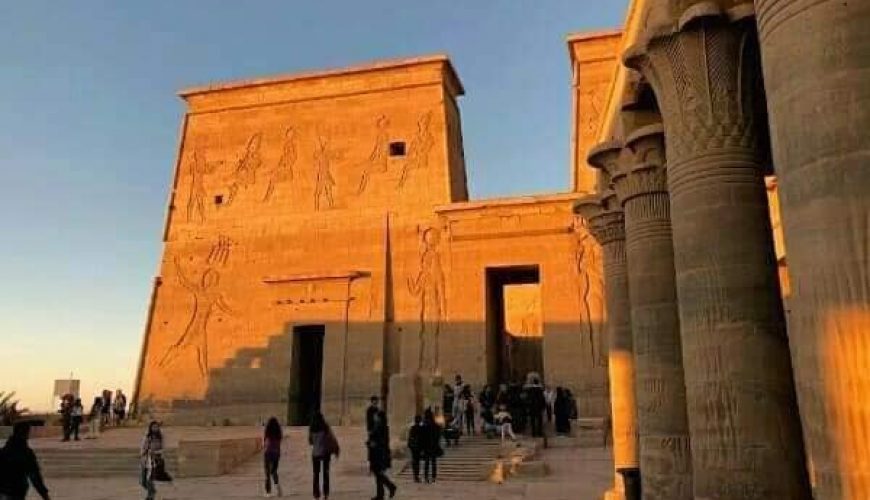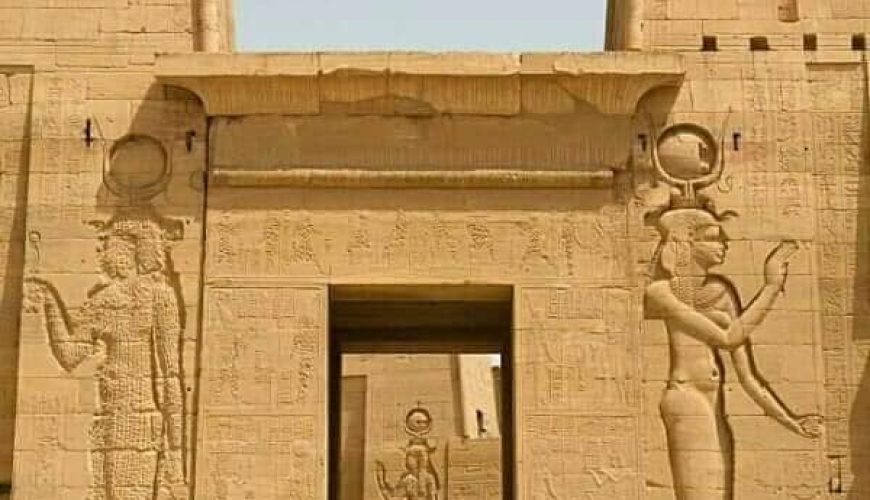Egypt Magic [1486]
The temple of the goddess Isis is the most important archaeological landmark on the island of Philae. The Isis temple begins with the outer courtyard, which dates back to the end of the Ptolemaic era to Augustus, the first Roman emperors.
On the right side of the outer courtyard of the temple of Isis, there is the characteristic of the eastern columns, which were not completed. Only between 6-16 cylinders were completed. The other columns were roughly carved and not completed. There are five doors in the back wall of the eastern facade that lead to various chapels (arsenovis compartment – compartment Mandulis – Imhotep cabin).
On the left side of the courtyard, there is the characteristic of the western columns, its length is 93 meters, and it has 31 cylinders. The number of the masts was originally 32 cylinders, and the lost barrel is currently in the Berlin Museum, and each column rises 5.10 m with crowns of various shapes. Most of the masts have views of Emperor Tiberius offering offerings To a goddess, and on the ceiling of the adjective, there are scenes of the stars and the flying eagle.
On the back wall there are two rows of scenes, the upper row and the lower row, in the upper row three scenes start from the south to the north, the emperor Nero introduces the eye of Ujajat to Horur, Tasent Nefert and Harpocrates, and wine to Sobek and Horus, and the emperor Claudius gives urgency to Sobek and Hathor And Khonsu, followed by nine scenes, beginning with Emperor Tiberius presenting Haiyan to Ozer, Isis, Horus, Amun-Ra and Thoth, then Tiberius offering an offering to Ozer, Isis, Horus, and Hathor, followed by the Emperor Augustus offering the manat necklace to Isis, Hathor, Horus, and Isis, and Tiberius presenting the Agates to Isis and Ozer, Tiberius worships to Ozer, Nunnefer, Isis, and his god, and Thoth lost his head, and Thoth in Nubus and Tefnut, and Tiberius offers clothes and fat to Ozer, Nenefer, Isis and Khnum Ra, and two forms of the goddess Hathor, and Tiberius offers barley to Maine Ra, Rabbit and Nephthys, and Tiberius stands before Isis Horus, Thoth, and Nubus, and Tiberius, offering the cobra snake to Isis (the rest of the scene is damaged.
In the lower row, the views intersect with the balconies, and the view begins from the south, where the emperor makes a sign? To Hor War, Sobek, Tasent, Nefert, Tefnut, Hathor, Harpocrates, and Tiberius introduces the enemies to Arsinophis, Thoth, and Tefnut, then ten scenes follow. Tiberius offers incense and water to Osir, Nnefer, Isis and Horus, and offers the contract to Isis, Hathor, Hor Sas, and Augustus. He offers symbols to Isis, Osir, Nunefer, and Horus. Tiberius offers wine to Arsinophis and Tefnut, Augustus presents a sign to Isis and Hathor. Tiberius presents crowns to Horus, Isis, Horus Isis, and Augustus offers milk to Osir, Nnefer, Isis and Horus, and provides fat to Arsenophis and Tefnut. He offers incense and water to Ozer, Nenefer, Isis and Horus (the damaged view).
As such, there is a staircase that goes down to a small scale.
The courtyard is followed by the first pylon, which is eighteen meters high and 45.5 meters wide, and the edifice consists of two towers and has two entrances, one of which is the main one, the middle and the second auxiliary, and has inscriptions of Ptolemy Philomator and leads to the birth house. The middle entrance is decorated with decorations from the era of Nectanebo I. On the walls of the eastern tower, there is the king Ptolemy XII strikes enemies with Isis, Horus, Edfu, and Hathor on the left, above them two inscriptions of King Ptolemy XII, the crowns of Upper and Lower Egypt, to Horus and Nephthys, on the right, and offers incense to Isis and Harpocrates on the left. There are similar scenes on the western tower, and at the bottom, there is a text in Demotic and Greek.
In front of the first pylon of the Temple of Isis, two lions of pink granite are from the Roman era. There were also two obelisks of pink granite built by Ptolemy VIII Yorgtes II and his wife Cleopatra III. On one of the bases of the obelisks, there was a text of the priests of Isis complaining to the Pharaoh that the temple paid taxes. The obelisks They were taken out of Egypt by the British Consul Henry Salt and Giovanni Battista Belzoni. They are now in Dorset, England, and they had contributions to deciphering the ancient Egyptian language.
Behind the first pylon is a courtyard.
There is a birth house on the western side of the courtyard, and the birth house was given to Isis. The king used to perform rituals inside it to prove his lineage to Isis and Horus to prove his legitimacy in assuming the rule of Egypt. Columns on the four sides surrounded the birth house, and its columns had vegetal crowns topped with crowns—the clay. On the walls, columns and wall draperies between the columns, there are scenes and texts of King Ptolemy VIII Yorgatis II, Ptolemy XII, Augustus and Tiberius, and among the most important scenes are the ones in the last room, which is Horus, depicted as a falcon in the swamps of the Delta. Isis sucks Horus in the swamps, and other scenes depict Horus in his childhood.
The courtyard is followed by a second edifice, and the height of the second pylon to the Temple of Isis is 12 meters and its width is 32 meters, and on the middle entrance there are views of Ptolemy Jorgtes II, and in the lower part of the eastern tower there is a large view of Ptolemy XII as he guides sacrificial animals to Horus and Hathor and above it there are two small scenes They depict the king offering a wreath to Horus and Nephthys, on the right and on the left, offering incense and pouring holy water on an altar in front of Osiris, Isis and Horus, and the natural granite rock at the bottom of the eastern tower was polished to form a panel with a text of six lines and a scene depicting the pillars that King Ptolemy gave Philomatore In 157 BC, the western tower bears similar scenes, but they have been erased, and in front of the edifice there are foundations of a shed, and the visitor can go up the second pylon from a staircase on the northern side of the western tower, and in the middle entrance there are faded views of early Christianity.
Behind the second pylon is the main temple of Isis, which consists of a courtyard, a transverse hall, a group of front rooms, and a mihrab that housed a statue of the goddess Isis, and the walls covered scenes and texts depicting Ptolemaic kings such as Ptolemy VIII and Roman emperors such as Augustus, Tiberius and Antoninus Pius offering sacrifices and performing some rituals.
In the transverse hall, there are eight columns and separated from the courtyard by the walls located between the front columns (wall curtains). The transverse hall and the courtyard were transformed into a Christian church, and crosses were carved on the walls. There is a Greek text stating that this part was transformed into a church by Bishop Theodore during the reign of the Roman Emperor Justinian. Above the entrance is a text of the archaeological mission sent to Elephants in 1841 by Pope Gregory XVI.
The temple ends with a mihrab, which is a small room with two small windows. The stone base that Ptolemy III and his wife Bernice built, and on top of it was placed the Isis complex and his statue, and there are four rooms around the mihrab.





Comment (0)